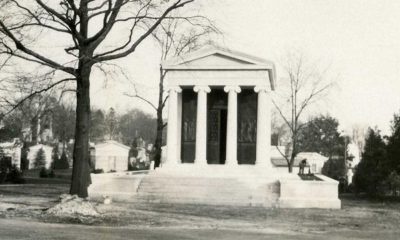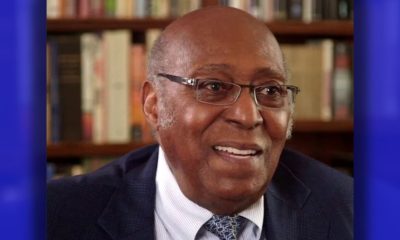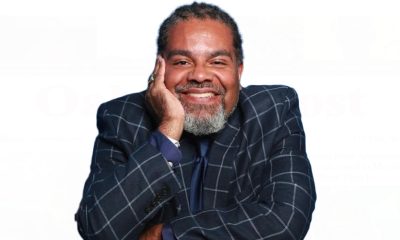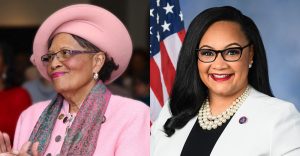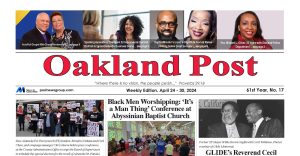#NNPA BlackPress
60 Years Ago: Students Launched Sit-In Movement
NNPA NEWSWIRE — Violent episodes were the exceptions and not the rule of the massively spreading Sit-in Movement. In nearly all sit-in cities, black protesters made immeasurable efforts to avoid violence at all cost since the movement and training centered on non-violent demonstrations in confronting inequality.

Dr. Kelton Edmonds is a Professor of History at California University of Pennsylvania. His primary research is on Black Student Activism in the United States. He is a native of Portsmouth, VA and graduated from I.C. Norcom High school in 1993.
By Dr. Kelton Edmonds, Special to The New Journal and Guide
February 1, 2020 marks the 60th anniversary of the launch of the historic Sit-in Movement, when four African-American freshmen from North Carolina A&T State College (now University) in Greensboro, NC sparked the non-violent and student-led wave of protests that ultimately resulted in the desegregation of F.W. Woolworth and other racially discriminatory stores.
The brave freshmen from NCA&T, who would later be adorned with the iconic label of the “Greensboro Four”, consisted of David Richmond, Franklin McCain, Joseph McNeil, and Ezell Blair Jr. (Jibreel Khazan). On February 1, 1960, the Greensboro Four bought items at Woolworth’s, then sat at the ‘whites-only’ lunch counter and refused to leave until they were served. Although waitresses refused to serve them, in accordance with the store’s racist policies, the four would continue their protest and in the following days and weeks would be joined by more students from NCA&T, the nearby all-women’s HBCU Bennett College and students from other nearby colleges and high schools.
In a 2003 interview, Khazan (formerly Blair, Jr.) reflected on the daily threats of violence and verbal assaults from white antagonists, as one caller reached him on the dorm hall phone and bellowed, “…executioners are going to kill you niggers if you come back down here tomorrow, you and your crazy friends.”
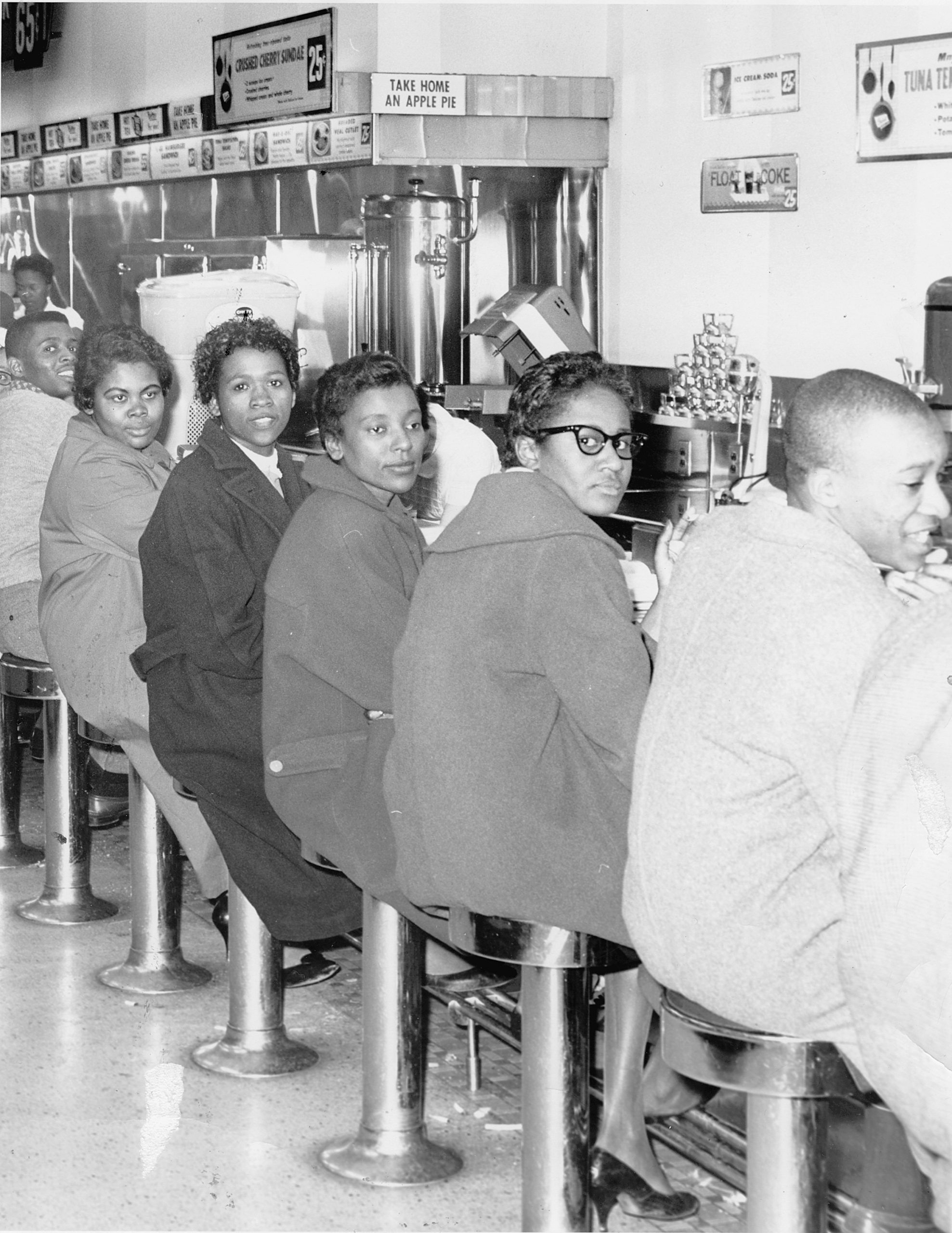
Students from Norfolk’s Booker T. Washington High School stage set in at Granby Street’s Woolworth’s lunch counter. Photo: New Journal and Guide Archives
White student allies who protested alongside black students were not immune from death threats either, as Khazan recalled a white student protester explaining that their college president was threatened by an anonymous caller saying, “…if those nigger loving bitches come downtown again and sit with those niggers, we going to kill them and burn your school down.”
The Greensboro students persisted nevertheless, and soon, the protests that flooded the lunch counters of the segregated store would spread to other cities throughout the South beginning in North Carolina cities such as Elizabeth City, Charlotte and Winston-Salem, in addition to cities in Virginia.
In Virginia
Virginia played a primary role in the Sit-in Movement, as Hampton, Virginia became the first community outside of North Carolina to experience sit-ins on February 10th.
Initially, three students from Hampton Institute sat-in at the downtown Woolworth’s lunch counter in Hampton and were refused service. As a testament to the veracity of the movement, within two weeks, over 600 students in Hampton were sitting-in.
On February 12th, sit-in protests spread to Norfolk, as 38 black protesters staged a sit-in at the Woolworth lunch counters on Granby and Freemason streets.
Similar demonstrations were held in Portsmouth, in the mid-city shopping center at lunch counters in Rose’s Department store on February 12th and at Bradshaw-Diehl department store later that week.
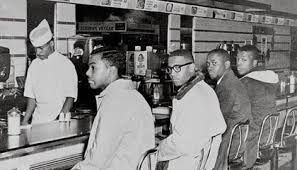
Led by students from I.C. Norcom High school, the Portsmouth sit-ins would be one of the few cities that experienced violence, albeit initiated by white anti-protesters armed with chains, hammers, and pipes and resulting in retaliation from the black students after being attacked.
Violent episodes were the exceptions and not the rule of the massively spreading Sit-in Movement. In nearly all sit-in cities, black protesters made immeasurable efforts to avoid violence at all cost since the movement and training centered on non-violent demonstrations in confronting inequality.
Edward Rodman, high school activist in Portsmouth, admitted they were initially unorganized and untrained in passive resistance, which played a role in their reactions to the violent anti-protesters. The Congress for Racial Equality (CORE) connected with the Portsmouth student protesters and over the next few days conducted intense and successful non-violent workshops with the young people. Soon after, the Portsmouth students reignited their movement without incidents of retaliation toward violent antagonists.
North of Hampton Roads, Richmond, Virginia experienced sit-ins as well as Baltimore, MD, and dozens of other cities by the end of February. By mid-April, sit-in protests reached all southern states involving thousands of black student activists and sympathizers.
The coordinated demonstrations of thousands of black student protesters and sympathizers put insurmountable pressure on Woolworth’s, as it became nearly impossible for regular customers to purchase items, eat at the lunch counters and even enter the store in many instances.
On May 25th, the sit-in movement received a major victory as lunch counters at Woolworth’s in Winston Salem, NC desegregated. Soon after, Woolworth’s in Nashville, TN and San Antonio, TX also integrated. Finally, on July 25, ground zero, Woolworth’s in Greensboro integrated its lunch counter. With the possibility of facing bankruptcy, F.W. Woolworth totally acquiesced and desegregated all of its lunch counters throughout the nation by the end of the summer of 1960.
The Legacies And Larger Significance Of The 1960 Sit-in Movement, Sparked In Greensboro
Similar to the successful 1955 Montgomery Bus Boycott, the students’ triumphant coordinated protests in 1960 further demonstrated how mass economic boycotts could lead to desegregationist social victories, particularly when targeting businesses that relied heavily on black patronage. The Greensboro Four only set out to challenge and change the discriminatory practices of the local Woolworth’s, yet their movement expanded exponentially to ultimately bring about the desegregation of all Woolworth’s lunch counters in the country.
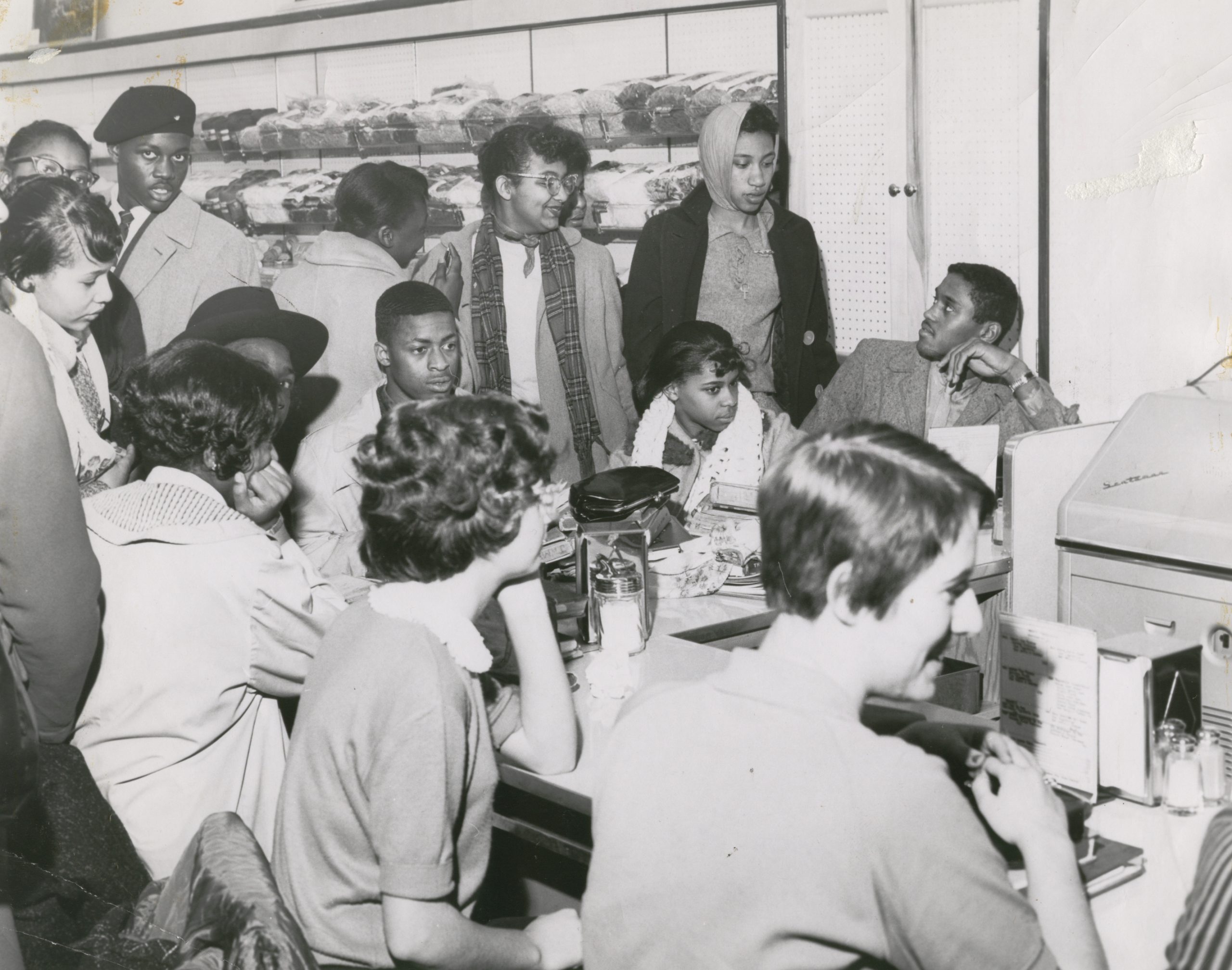
Unidentified sit-in demonstration. Photo: New Journal and Guide Archives
The students of the Civil Rights era suddenly possessed a new weapon, the mass sit-in, which would continue to be used in Greensboro and around the country in various forms. The sit-ins combined with the freedom rides led to black students establishing their unique value and niche to the larger Civil Rights Movement. Black students understood their unique, collective power and desired to harness their efforts under a national apparatus. Consequently, another major legacy of the student movement that emerged in Greensboro was it also directly led to the birth of the Student Non-Violent Coordinating Committee (SNCC) in April of 1960 in nearby Raleigh, NC on the campus of Shaw University.
SNCC would soon emerge as one of the most formidable organizations of the decade, elevating students to the forefront of the Civil Rights Movement.
After marveling at the magnitude and effectiveness of the student protesters during the sit-ins, major Civil Rights organizations such as the NAACP, SCLC and CORE pressured the students to collapse their meteoric movement into the youth wing of one of their institutions under their supervision.
The students however, decided to remain autonomous and formulate their own student-led organization, while still adhering to non-violent principles. The students’ decision to remain student-led received noteworthy support from several key adult Civil Rights leaders in Greensboro in addition to Ella Baker from SCLC.
SNCC would prove to be an indispensible organization that not only championed directly confronting Jim Crow racism on numerous levels through organized protests and massive voter registration drives, but SNCC also further popularized the concept of participatory democracy and was the first major Civil Rights organization to evolve toward seriously embracing principles of black power ideology under Stokely Carmichael’s (Kwame Ture) leadership in 1966.
Another legacy of the 1960 sit-in movement was that it offered the inspiration and blueprint for the second and more colossal wave of mass student protest in Greensboro in 1963. The 1963 student demonstrations in Greensboro would be even more locally successful than their predecessor as they desegregated all remaining businesses in downtown Greensboro and the student leader of the second wave of sit-ins, Jesse Jackson, would parlay his leadership in the student protests onto the national Civil Rights stage throughout the 20th century. Similar to Greensboro, other cities throughout the South would experience a second and even third wave of similar protests to successfully desegregate other remaining businesses throughout the decade.
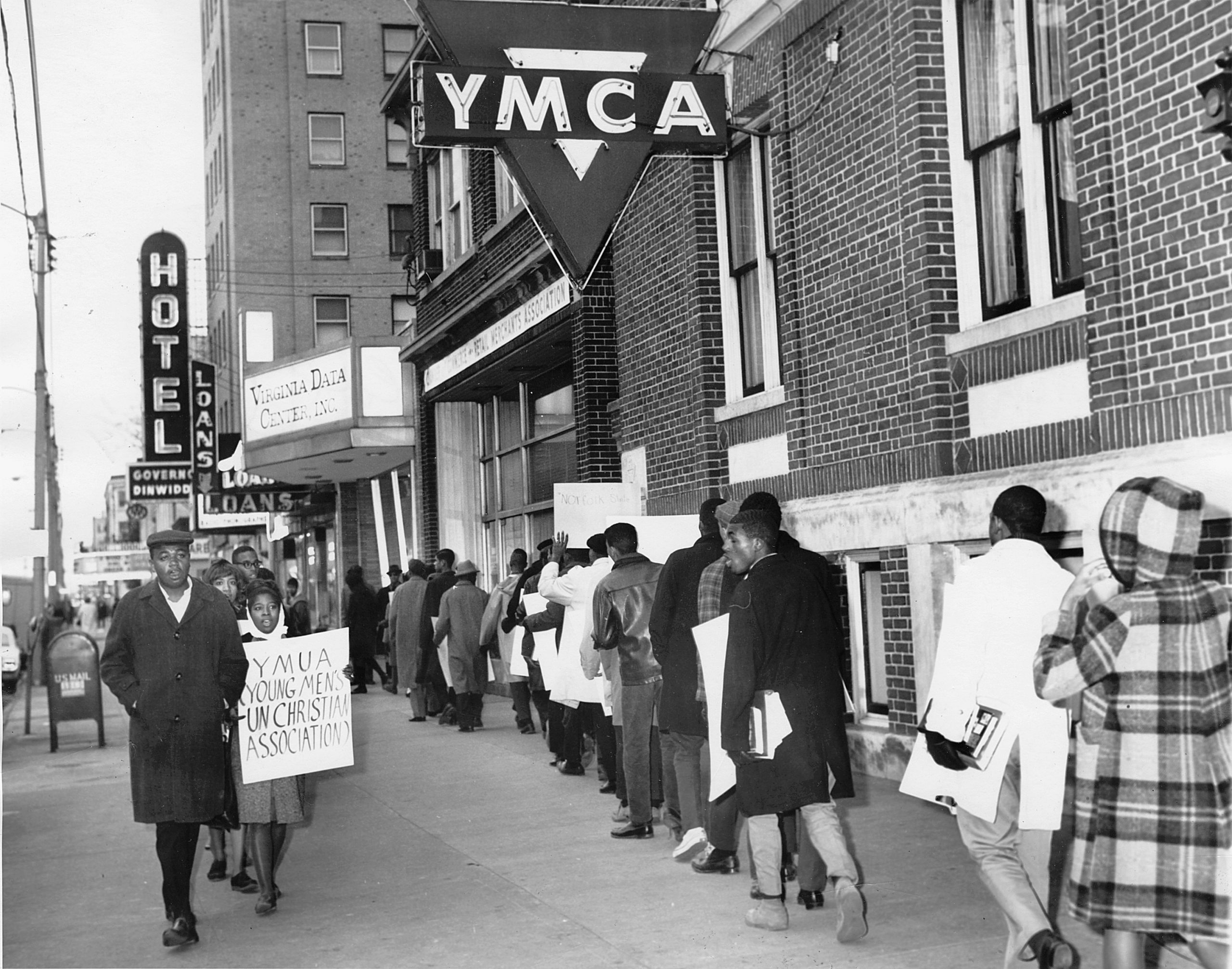
Ultimately, all mass student protests of the 1960s and thereafter owe their viability to the student-led Greensboro protests of 1960, including student black power activists and anti-war activists of the late 60s and 70s. Although its origins predate 1960, even one of the largest and most noteworthy national student organizations, Students for a Democratic Society (SDS), owe its resurgence and major elements of its effectiveness to the spark ignited by the Greensboro Four on February 1, 1960.
Even recent episodes of student activism exhibited in the Ferguson, Missouri protests of 2014-15, as well as the student protests led by black students at the University of Missouri in 2015, which ultimately led to the resignation of the chancellor, have attributes that correlate to the 1960 student movement. The student movement of 1960, ignited by the Greensboro Four, provided a blueprint for future students to build upon, perfect, and utilize in a variety of ways for a plethora of circumstances.
Most importantly, what happened in 1960 showed young people the power they possessed to address their grievances and ultimately bring about change on both local and national levels if they organized themselves and remained committed.
Unique Weapons for Non-violent Students
In addition to the typical traits that come along with youthfulness such as idealism and impatience, student success during the 1960 sit-ins and thereafter was directly affixed to two distinct assets possessed by students juxtaposed to their older adult activist counterparts. The first asset is condense demographics, as student-body populations were primarily located on campuses and/or nearby the colleges.
The fact that hundreds to thousands of students in a college town lived within a square mile of each other led to the expeditious mobilization of large numbers of people and efficient dissemination of information and strategy.
Although black churches proved to be invaluable throughout the Black Freedom Struggle from Reconstruction to the Civil Rights Movement, there was still no equivalent amongst the older black generation to the college campus’ effectiveness as both a meeting place and as a domicile for housing and dispersing the shock troops of the movement.
The second major asset specific to students would be the relation between arrest and reprisal. At some of their demonstrations prior to 1960, older black activists strategically triggered their arrests for charges such as trespassing or loitering as a way to dramatize unjust treatment via media coverage and to pressure white officials to change discriminatory laws.
Once mobilized per the sit-ins however, student activists were able to invite and withstand incarceration for far longer periods of time and in extremely larger numbers. Students vastly elevated this critical strategy of the overall movement. During 1960 and beyond, the enormous numbers unleashed by black student activists put unyielding pressure on local law enforcement, political officials and jail facilities. In many cities like Greensboro, there were not enough jail cells for all of the students arrested, particularly since the students refused bail and chose to remain incarcerated.
This action severely drained local municipalities of money and resources, forcing local governmental, business and law officials to dramatically adjust policies and sometimes change discriminatory laws. Student activists were able to perfect this strategy because they could endure prolonged imprisonment without fear of major job or housing reprisal.
Comparably, many older activists, whose families depended on their incomes, could not sacrifice prolonged periods of incarceration, as it would threaten their livelihood. Furthermore, angry employers or landlords, who disapproved of their protest activities, could threaten to fire them or abruptly remove them from property they were renting.
Students were not confronted with the same ramifications of these economic, employment and housing reprisals, as the majority of them lived on campuses and perhaps had part-time, albeit replaceable, minimum wage jobs, often with no dependents.
Drawing the contrast between student activists versus the older activists is not synonymous with drawing divisions, as the older activists understood the assets that students solely possessed to further the movement along. In fact, many of the older activists encouraged the younger activists and actively supported them in numerous ways.
For example, when Bennett College students, who were the heroines on the 1963 Greensboro protests, were arrested and refused bail during the 1963 sit-ins in Greensboro, their professors came to the jail facilities and gave them their classroom and homework assignments every week. This scenario personifies the symbiotic relationship between both generations in the fight against racism, as the professors showed their appreciation for the young people’s unique and valiant position for the benefit of the entire race and future generations, yet not removing the students from their responsibilities and academic requirements.
Altogether, students endured countless hardships that included incarceration, verbal assaults and physical violence. Sometimes, attacks from white antagonists were compounded by disproportionate responses from law enforcement, as Portsmouth activist, Edward Rodman explained, “…the fire department, all of the police force and police dogs were mobilized. The police turned the dogs loose on the Negroes-but not all the whites.”
Students also understood that they could pay the ultimate price for protesting against the status quo of racial inequality, as numerous activists were murdered throughout the Civil Rights era. Nevertheless, over 50,000 black students and sympathizers participated in the sit-ins of 1960. As historian Clayborne Carson highlighted, “Nonviolent tactics, particularly when accompanied by rationale based on Christian principles, offered black students…a sense of moral superiority, an emotional release through militancy, and a possibility of achieving desegregation.”
A movement within a movement was born on February 1, 1960 and that movement evolved into its own distinct force by the middle of the decade. Soon after the sit-ins began, students realized their collective prowess, as student activism consistently helped define the decade of the 60s in forcing monumental political, legal and social changes throughout the nation.
Finally, the black student activists of the 1960 sit-ins did three important things, albeit unintentional: they helped lay the foundation for all collective student activism in the 60s and beyond, they played a legendary role in the larger African-American Freedom Movement that began as early as Africans’ arrival to colonial America, and they cemented a valuable place in one of America’s most significant traditions, the protest tradition, which has continuously defined and propelled our country since its inception.
Our society, and all post-1960 social movements, have undeniably benefited from the audacity of those four brave freshmen and their actions on February 1, 1960.
Dr. Kelton Edmonds is a Professor of History at California University of Pennsylvania. His primary research is on Black Student Activism in the United States. He is a native of Portsmouth, VA and graduated from I.C. Norcom High school in 1993. He holds B.A. and M.A. degrees in Secondary Education-History from North Carolina A&T State University. He earned his Ph.D. in 20th Century US History from the University of Missouri-Columbia.
#NNPA BlackPress
IN MEMORIAM: Ramona Edelin, Influential Activist and Education Advocate, Dies at 78
NNPA NEWSWIRE — Born on September 4, 1945, in Los Angeles, California, activist Ramona Edelin’s early years were marked by a commitment to education and social justice. According to her HistoryMakers biography, after graduating from Fisk University with a Bachelor’s degree in 1967, she pursued further studies at the University of East Anglia in England. She earned her master’s degree before completing her Ph.D. at Boston University in 1981.
The post IN MEMORIAM: Ramona Edelin, Influential Activist and Education Advocate, Dies at 78 first appeared on BlackPressUSA.

By Stacy M. Brown, NNPA Newswire Senior National Correspondent
@StacyBrownMedia
Once upon a time, Black Americans were simply known as colored people, or Negroes. That is until Ramona Edelin came along. The activist, renowned for her pivotal roles in advancing civil rights, education reform, and community empowerment, died at her D.C. residence last month at the age of 78. Her death, finally confirmed this week by Barnaby Towns, a communications strategist who collaborated with Dr. Edelin, was attributed to cancer.
Born on September 4, 1945, in Los Angeles, California, Edelin’s early years were marked by a commitment to education and social justice. According to her HistoryMakers biography, after graduating from Fisk University with a Bachelor’s degree in 1967, she pursued further studies at the University of East Anglia in England. She earned her master’s degree before completing her Ph.D. at Boston University in 1981.
Edelin’s contributions to academia and activism were manifold. She was pivotal in popularizing the term “African American” alongside Rev. Jesse L. Jackson in the late 1980s.
Jackson had announced the preference for “African American,” speaking for summit organizers that included Dr. Edelin. “Just as we were called Colored, but were not that, and then Negro, but not that, to be called Black is just as baseless,” he said, adding that “African American” “has cultural integrity” and “puts us in our proper historical context.”
Later, Edelin told Ebony magazine, “Calling ourselves African Americans is the first step in the cultural offensive,” while linking the name change to a “cultural renaissance” in which Black Americans reconnected with their history and heritage.
“Who are we if we don’t acknowledge our motherland?” she asked later. “When a child in a ghetto calls himself African American, immediately he’s international. You’ve taken him from the ghetto and put him on the globe.”
The HistoryMakers bio noted that Edelin’s academic pursuits led her to found and chair the Department of African American Studies at Northeastern University, where she established herself as a leading voice.
Transitioning from academia to advocacy, Edelin joined the National Urban Coalition in 1977, eventually ascending to president and CEO. During her tenure, she spearheaded initiatives such as the “Say Yes to a Youngster’s Future” program, which provided crucial support in math, science, and technology to youth and teachers of color in urban areas. Her biography noted that Edelin’s efforts extended nationwide through partnerships with organizations like the National Science Foundation and the United States Department of Education.
President Bill Clinton recognized Edelin’s expertise by appointing her to the Presidential Board on Historically Black Colleges and Universities in 1998. She also co-founded and served as treasurer of the Black Leadership Forum, solidifying her standing as a respected leader in African American communities.
Beyond her professional achievements, Edelin dedicated herself to numerous boards and committees, including chairing the District of Columbia Educational Goals 2000 Panel and contributing to the Federal Advisory Committee for the Black Community Crusade for Children.
Throughout her life, Edelin received widespread recognition for her contributions. Ebony magazine honored her as one of the 100 Most Influential Black Americans, and she received prestigious awards such as the Southern Christian Leadership Award for Progressive Leadership and the IBM Community Executive Program Award.
The post IN MEMORIAM: Ramona Edelin, Influential Activist and Education Advocate, Dies at 78 first appeared on BlackPressUSA.
#NNPA BlackPress
Tennessee State University Board Disbanded by MAGA Loyalists as Assault on DE&I Continues
NNPA NEWSWIRE — Recent legislative actions in Tennessee, such as repealing police reform measures enacted after the killing of Tyre Nichols, underscore a troubling trend of undermining local control and perpetuating racist agendas. The new law preventing local governments from restricting police officers’ authority disregards community efforts to address systemic issues of police violence and racial profiling.
The post Tennessee State University Board Disbanded by MAGA Loyalists as Assault on DE&I Continues first appeared on BlackPressUSA.
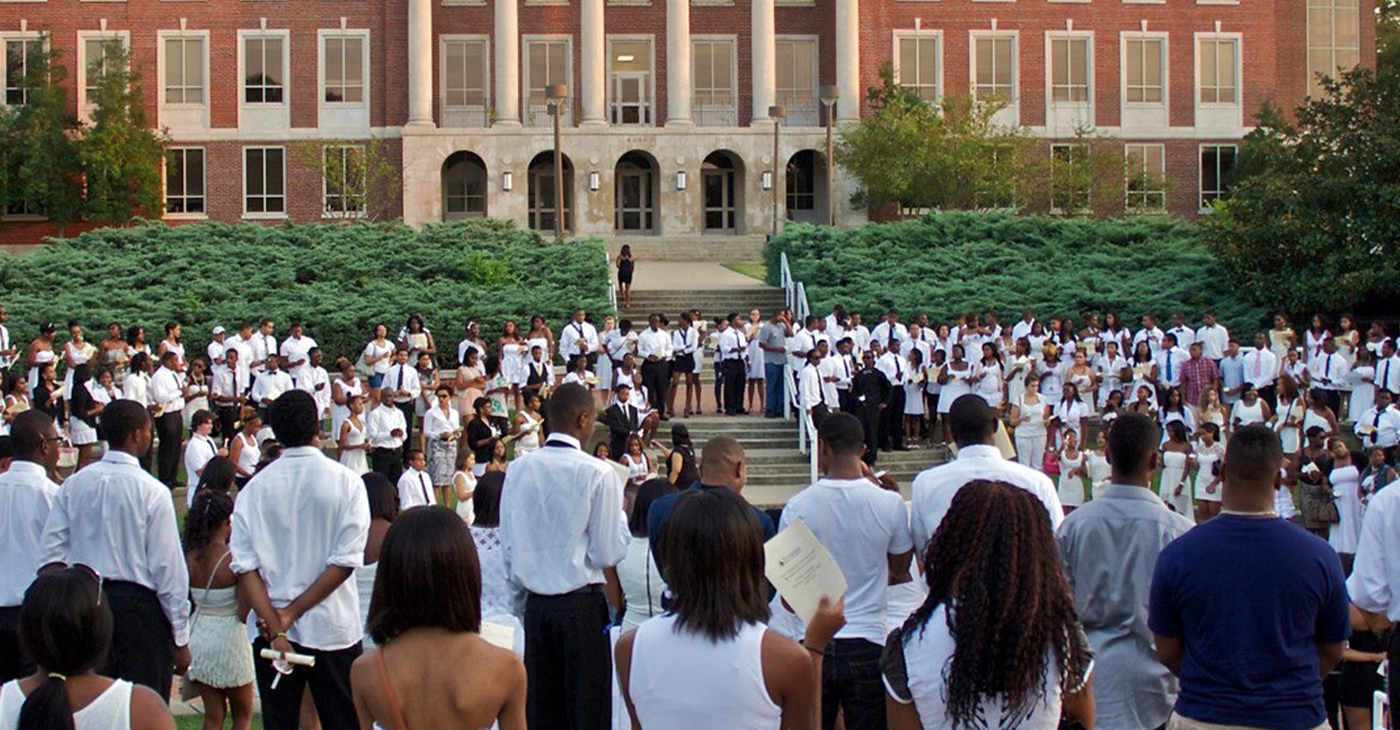
By Stacy M. Brown, NNPA Newswire Senior National Correspondent
@StacyBrownMedia
Tennessee State University (TSU), the state’s only public historically Black college and university (HBCU), faces a tumultuous future as Gov. Bill Lee dissolved its board, a move supported by racist conservatives and MAGA Republicans in the Tennessee General Assembly, who follow the lead of the twice-impeached, four-times indicted, alleged sexual predator former President Donald Trump. Educators and others have denounced the move as an attack on diversity, equity, and inclusion (DE&I) and a grave setback for higher education.
Critics argue that TSU’s purported financial mismanagement is a manufactured crisis rooted in decades of underinvestment by the state government. They’ve noted that it continues a trend by conservatives and the racist MAGA movement to eliminate opportunities for Blacks in education, corporate America, and the public sector.
Gevin Reynolds, a former speechwriter for Vice President Kamala Harris, emphasizes in an op-ed that TSU’s financial difficulties are not the result of university leadership because a recent audit found no evidence of fraud or malfeasance.
Reynolds noted that the disbanding of TSU’s board is not an isolated incident but part of a broader assault on DE&I initiatives nationwide. Ten states, including Tennessee, have enacted laws banning DE&I policies on college campuses, while governors appointing MAGA loyalists to university trustee positions further undermine efforts to promote inclusivity and equality.
Moreover, recent legislative actions in Tennessee, such as repealing police reform measures enacted after the killing of Tyre Nichols, underscore a troubling trend of undermining local control and perpetuating racist agendas. The new law preventing local governments from restricting police officers’ authority disregards community efforts to address systemic issues of police violence and racial profiling.
The actions echo historical efforts to suppress Black progress, reminiscent of the violent backlash against gains made during the Reconstruction era. President Joe Biden warned during an appearance in New York last month that Trump desires to bring the nation back to the 18th and 19th centuries – in other words, to see, among other things, African Americans back in the chains of slavery, women subservient to men without any say over their bodies, and all voting rights restricted to white men.
The parallels are stark, with white supremacist ideologies used to justify attacks on Black institutions and disenfranchise marginalized communities, Reynolds argued.
In response to these challenges, advocates stress the urgency of collective action to defend democracy and combat systemic racism. Understanding that attacks on institutions like TSU are symptomatic of broader threats to democratic norms, they call for increased civic engagement and voting at all levels of government.
The actions of people dedicated to upholding the principles of inclusivity, equity, and justice for all will determine the outcome of the ongoing fight for democracy, Reynolds noted. “We are in a war for our democracy, one whose outcome will be determined by every line on every ballot at every precinct,” he stated.
The post Tennessee State University Board Disbanded by MAGA Loyalists as Assault on DE&I Continues first appeared on BlackPressUSA.
#NNPA BlackPress
Braxton Haulcy and the Expansion of Walker|West Music Academy
May 24, 2023 – Walker West Music Academy gets an early start on expansion. Join us for a Wednesday episode of The …
The post Braxton Haulcy and the Expansion of Walker|West Music Academy first appeared on BlackPressUSA.

May 24, 2023 – Walker West Music Academy gets an early start on expansion. Join us for a Wednesday episode of The …
The post Braxton Haulcy and the Expansion of Walker|West Music Academy first appeared on BlackPressUSA.
-
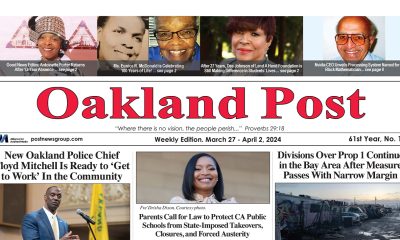
 Activism4 weeks ago
Activism4 weeks agoOakland Post: Week of March 27 – April 2, 2024
-
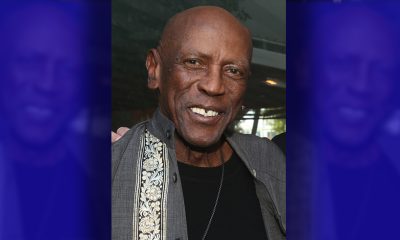
 #NNPA BlackPress4 weeks ago
#NNPA BlackPress4 weeks agoBeloved Actor and Activist Louis Cameron Gossett Jr. Dies at 87
-
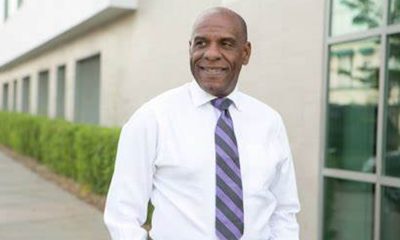
 Community1 week ago
Community1 week agoFinancial Assistance Bill for Descendants of Enslaved Persons to Help Them Purchase, Own, or Maintain a Home
-

 Activism3 weeks ago
Activism3 weeks agoOakland Post: Week of April 3 – 6, 2024
-
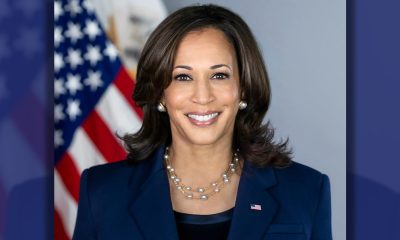
 Business1 week ago
Business1 week agoV.P. Kamala Harris: Americans With Criminal Records Will Soon Be Eligible for SBA Loans
-
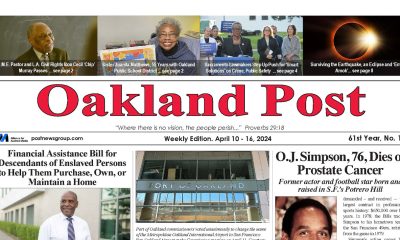
 Activism2 weeks ago
Activism2 weeks agoOakland Post: Week of April 10 – 16, 2024
-
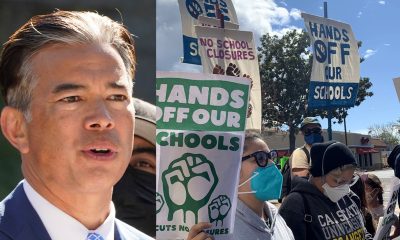
 Community1 week ago
Community1 week agoAG Bonta Says Oakland School Leaders Should Comply with State Laws to Avoid ‘Disparate Harm’ When Closing or Merging Schools
-
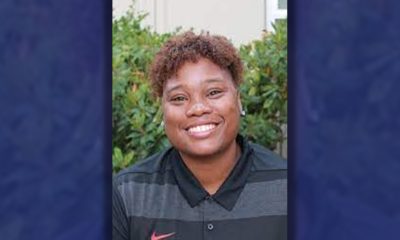
 Community6 days ago
Community6 days agoOakland WNBA Player to be Inducted Into Hall of Fame





